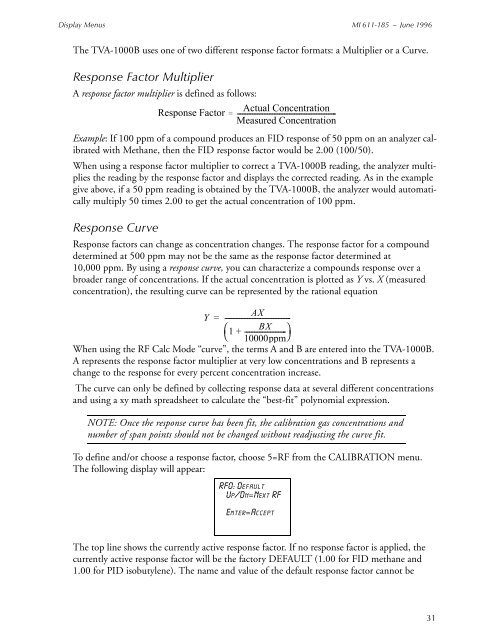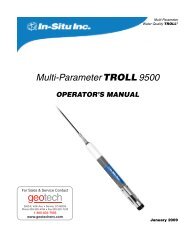Thermo Scientific TVA-1000B Instruction Manual - Geotech ...
Thermo Scientific TVA-1000B Instruction Manual - Geotech ...
Thermo Scientific TVA-1000B Instruction Manual - Geotech ...
You also want an ePaper? Increase the reach of your titles
YUMPU automatically turns print PDFs into web optimized ePapers that Google loves.
Display Menus MI 611-185 – June 1996<br />
The <strong>TVA</strong>-<strong>1000B</strong> uses one of two different response factor formats: a Multiplier or a Curve.<br />
Response Factor Multiplier<br />
A response factor multiplier is defined as follows:<br />
Example: If 100 ppm of a compound produces an FID response of 50 ppm on an analyzer calibrated<br />
with Methane, then the FID response factor would be 2.00 (100/50).<br />
When using a response factor multiplier to correct a <strong>TVA</strong>-<strong>1000B</strong> reading, the analyzer multiplies<br />
the reading by the response factor and displays the corrected reading. As in the example<br />
give above, if a 50 ppm reading is obtained by the <strong>TVA</strong>-<strong>1000B</strong>, the analyzer would automatically<br />
multiply 50 times 2.00 to get the actual concentration of 100 ppm.<br />
Response Curve<br />
Response Factor<br />
=<br />
----------------------------------------------------------<br />
Actual Concentration<br />
Measured Concentration<br />
Response factors can change as concentration changes. The response factor for a compound<br />
determined at 500 ppm may not be the same as the response factor determined at<br />
10,000 ppm. By using a response curve, you can characterize a compounds response over a<br />
broader range of concentrations. If the actual concentration is plotted as Y vs. X (measured<br />
concentration), the resulting curve can be represented by the rational equation<br />
Y = ----------------------------------------<br />
AX<br />
⎛1<br />
+ -------------------------<br />
BX ⎞<br />
⎝ 10000ppm⎠<br />
When using the RF Calc Mode “curve”, the terms A and B are entered into the <strong>TVA</strong>-<strong>1000B</strong>.<br />
A represents the response factor multiplier at very low concentrations and B represents a<br />
change to the response for every percent concentration increase.<br />
The curve can only be defined by collecting response data at several different concentrations<br />
and using a xy math spreadsheet to calculate the “best-fit” polynomial expression.<br />
NOTE: Once the response curve has been fit, the calibration gas concentrations and<br />
number of span points should not be changed without readjusting the curve fit.<br />
To define and/or choose a response factor, choose 5=RF from the CALIBRATION menu.<br />
The following display will appear:<br />
RF0: Default<br />
Up/Dn=Next RF<br />
Enter=Accept<br />
The top line shows the currently active response factor. If no response factor is applied, the<br />
currently active response factor will be the factory DEFAULT (1.00 for FID methane and<br />
1.00 for PID isobutylene). The name and value of the default response factor cannot be<br />
31

















